RGB strip lighting has seen an exponential increase in the past decade. Their slim and sleek form factor and variable lighting color have made them a go-to option for modern accent and mood lighting.
However, with their increase in popularity, several variations have popped up with confusingly similar names like RGBW and RGBWW.
This article explains the key difference between RGB and RGBW strip lights and the benefits of RGBW technology.
What Are RGB LED Strip Lights?
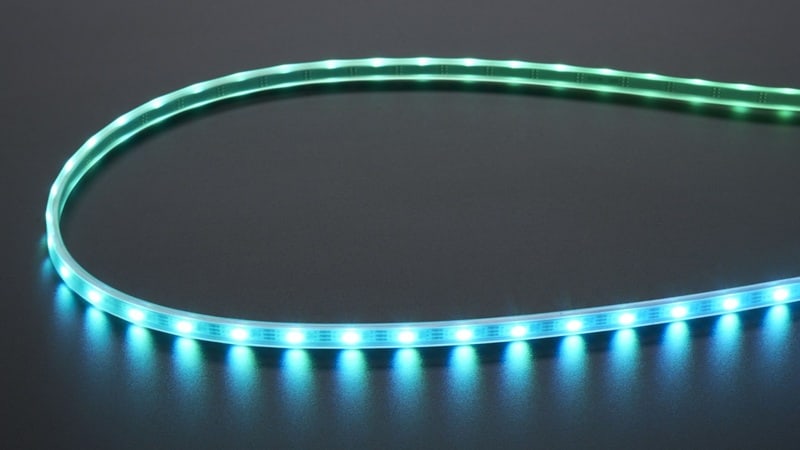
RGB LED stands for Red, Green, and Blue Light Emitting Diode and consists of three colored lighting channels, each designed to output at varying brightness levels. The colors can be rendered at a level between 0 to 255.
You can mix and create new colors by tuning the values of red, green, and blue in a LED. RGB LED strips can output over 16 million colors by mixing red, green, and blue.
RGB LED lights display blue by setting the red and green channels to zero (0) and the blue channel to maximum (255).
Similarly, these LED lights can display other colors, like purple, by setting green to zero and red & blue channels to a high value. White color is simulated by running all channels at 255. The following table shows the total number of colors supported by RGB LED.
| Channel | Red | Green | Blue |
| Levels | 226 | 226 | 226 |
| Lowest Value | 0 | 0 | 0 |
| Highest Value | 255 | 255 | 255 |
| Total Color Combinations | 16,777,216 (256 x 256 x 256) | ||
An RGB LED strip light is formed by attaching several compact RGB diodes in series to a flexible non-conductive flat rope. A controller is connected to the end of the LED strip light and manages the color output.
Some LED controllers provide additional features like remote access through wireless controllers, smartphones, and smart home devices.
These lights are low-voltage fixtures designed to offer accented or mood lighting effects to a space. As such most LED strip lights sold run at either 12 or 24 volts and require an external power supply.
LED strip lights are a flexible lighting solution that can be modified to accommodate certain applications. RGB LED products vary based on voltage, brightness, form factor, length, and water tightness.
Addressable RGB LED Strip Lights
Standard RGB LED strips are limited to one color at a time. The RGB controller can change the color of the strip lights, but it cannot control each individual LED module.
Addressable RGB LED strip lights can display multiple colors at the same time. Each LED in this configuration acts as an independent light fixture.
Addressable RGB or ARGB strips are most commonly used in PC hardware, where they can be paired with a smart controller hub to create unique lighting effects.
A standard RGB LED light strip can output all the rainbow colors but only display one color at a time. In comparison, an ARGB strip can simultaneously display multiple colors to create a rainbow gradient.
Diodes and Channels
A diode is a semiconductor switch that emits light when current passes through it. The color of a diode depends on the materials used in its construction. Different materials produce different wavelengths of light when exposed to an electric current.
A channel is the sub-categorization of a signal diode. RGB LEDs contain a unique semiconductor pattern that stores three colors in one diode. These color elements are called channels, and some LEDs can have more than three channels.
Variations on RGB LED Strips
RGB LEDs are a blank canvas that can be painted to your heart’s desire. The LED module of a strip light has a few variations that can completely change the color and quality of the output light. Following are some of the most popular variations of RGB strip lights.
| Acronym | Full Name |
| RGB | Red, Green, & Blue |
| RGBW | Red, Green, & Blue, plus Warm White |
| RGBWW | Red, Green, & Blue plus Warm White |
| RGBCW | Red, Green, & Blue plus Cool & Warm White |
| RGBCCT | Red, Green, & Blue plus Correlated Color Temperature |
| RGBIC | Red, Green, & Blue plus Independent Control |
RGBW LED Strip Lights
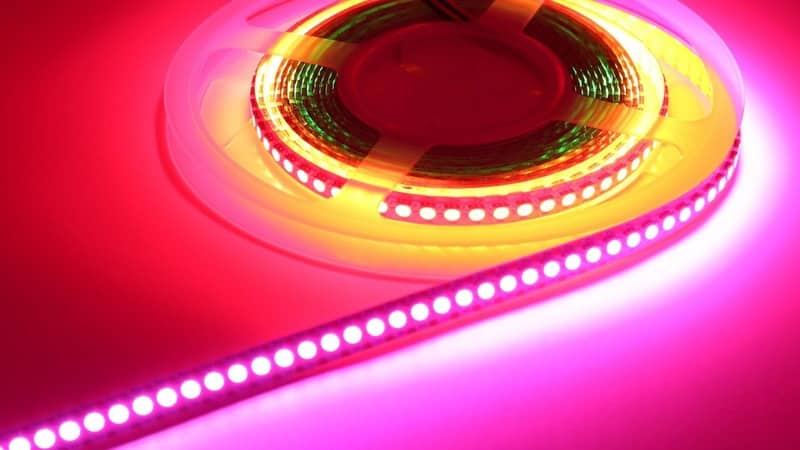
An RGBW LED Strip Light contains three color channels and one additional white light. Having another color channel helps these LED lights stand out based on brightness alone.
Standard RGB LED strips struggle to meet certain brightness thresholds. Hence, they are almost always used in conjunction with ambient light fixtures.
More Natural Colors
The extra white light also helps provide finer color mixing controls, resulting in more natural-looking lighting. RGB diodes cannot render pure white light.
Instead, it runs the three channels at full throttle (255) to mix and simulate white light. Thus, the presence of an actual white channel creates a more true white glow.
Design Complexity
RGBW LED strips are slightly more expensive than standard RGB led strip lights. The additional cost comes from the larger RGBW diodes and their increased manufacturing complexity. The added white light also comes with additional electronics requirements.
First is the higher power consumption. The white channel runs brighter and requires more wattage to be pumped into the LED strip.
The second is input. RGBW LED strips have five wire inputs (Red, blue, green, white, and ground) compared to the four wires on RGB LED lights.
RGBWW LED Strip Lights
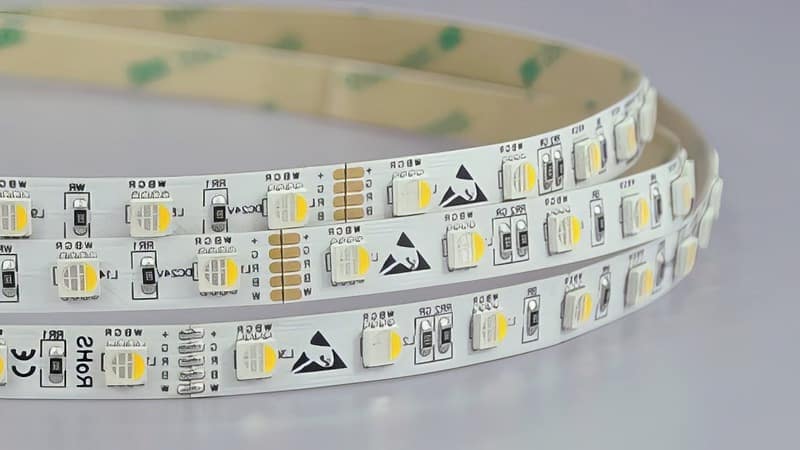
RGBWW (RGB + Warm White) LED strips contain a warmer white color channel in addition to the standard red, green, and blue channels. Warm white light has a more pleasant and softer look, which is preferred by many for indoor lighting.
Benefits of Warm Lighting
Cool white (blueish-white) light helps the viewer maintain focus and is often preferred in office spaces. In contrast, warm white (yellowish white) light is a more cozy feeling and is less harsh on the eyes. A warm white channel also helps reduce harshness in the light.
RGB Terminology
There is a misconception regarding the terminology of RGBWW LED lights. RGBWW stands for red, green, and blue, plus warm white. However, some mislabel this as RGB plus white and warm white.
RGBWW lights are generally preferred for nighttime outdoor lighting as the warm color temperature is less harsh at night than the cool white one.
Restaurants almost universally use warmer white LEDs for indoor and outdoor dining areas.
An RGB LED light with two white channels is sometimes called an RGBW+WW LED light. But it’s most likely an RGBCW LED strip that has been mislabeled.
RGBCW LED Strip Lights
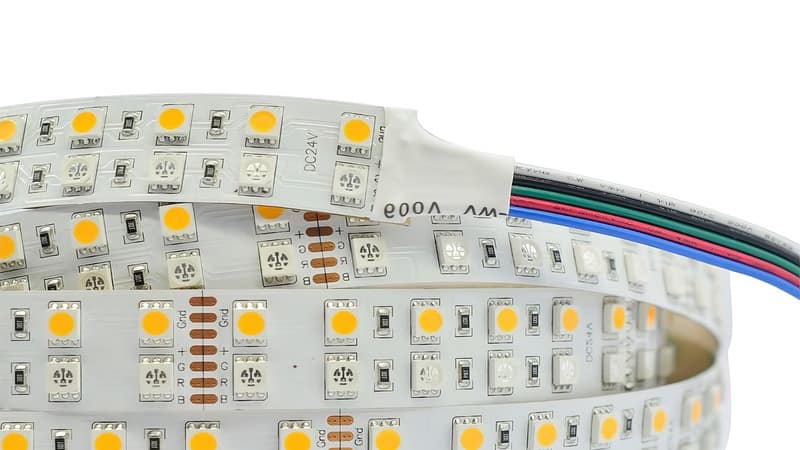
RGBCW (RGB + Cool & Warm) LED lights are five-channel lighting fixtures containing two white light-emitting diodes.
You can identify RGBCW lights by the presence of a small yellow and orange spot on the diode itself. Cool white LEDs have a light yellow surface color, whereas warm white ones have an orange surface.
Design Variations
Some RGBCW LED lights have a split design. They contain two series diodes: an RGB diode that controls the color and the CW diode responsible for the white light output.
Flexibility
Unlike RGBW, which only offer cool white, and RGBWW, which only offer warm white, CW LED lights allow users to switch between the two color temperatures of their lighting setup. Finer color control allows for more cohesive lighting effects, which is bound to excite smart home lighting enthusiasts.
Sometimes RGBCW is mistakenly defined as RGB plus Cool White. However, it should be noted that regular RGBW is the cool white alternative to RGBWW.
RGBCCT LED Strip Lights
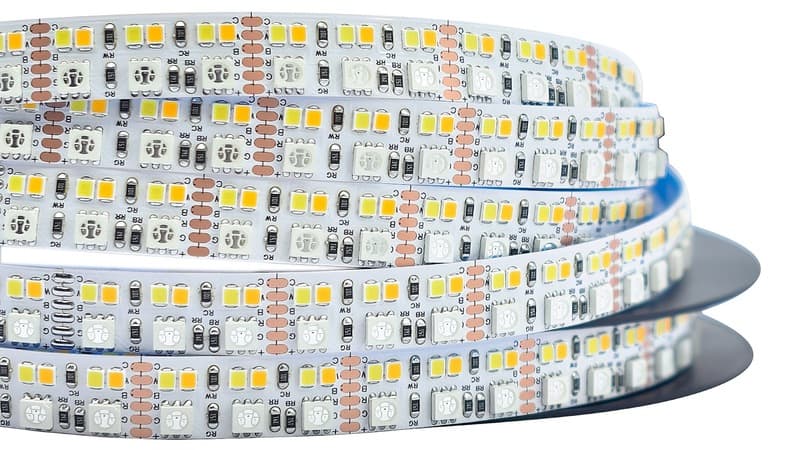
RGBCCT LED strip lights are an upgrade to RGBCW LED lighting. The CCT in the name stands for Correlated Color Temperature, which refers to LED light appearance specification. Basically, it means a white light is officially labeled warm if it has a CCT rating of 3200 Kelvin or less.
Advance Color Mixing
Modern RGBCCT LED strip lights combine the output of two white channels to create a range of color temperatures from cool to warm. You can find this finer color temperature adjustment in the accompanying digital app of a smart RGB LED strip light.
While RGBCW LED strips allow you to switch between warm and white hues, no color mixing is involved. A CCT LED strip has a smart controller that simultaneously tunes the two white channels.
By all accounts, CCT-compliant RGB LED lights are the best-LED lighting solution available on the market. However, this additional control and flexibility come with a hefty price tag.
RGBIC LED Strip Lights

RGBIC stands for RGB Independent Control, as it contains a smart control chip attached to the LED light strip. This control chip can individually control each diode in an RGBIC LED strip light.
The keen-eyed among you must have already noticed that this definition is the same as addressable RGB lights. And you are absolutely correct!
RGBIC is the technical term for addressable red, green, and blue lighting.
Creative Lighting
An RGBIC LED strip light can be programmed to display patterns, rainbow effects, and switch between lighting effects. The drawback is that they cannot be cut and resized like other RGB LED Lighting options.
The addition of an IC chip exponentially increases the cost of RGBIC LED light strips. When deploying multiple RGBIC LED lights, you will need the help of smart LED light controllers, which further increases the total cost of your lighting setup.
RGB vs. RGBW vs. RGBCCTW vs. RGBIC
RGB strip lights are a general all-purpose tool that provides cost-effective and unique lighting designs for your space. However, they often lack versatility and can be underwhelming in some scenarios.
The several variations on RGB LEDs aim to combat the limitations of the technology by adding more color channels and smart electronics.
| Technology | Color Channels | Theoretical Color Output | Cost | Advantages |
| RGB | 3 | 16M(2653) | Low | Lowest Cost |
| RGBW | 4 | 4.3B(2654) | Low | Brighter |
| RGBWW | 4 | 4.3B(2654) | Low | Brighter & Warmer |
| RGBCW | 5 | 4.3B(2654) | Medium | Brighter & Option to Switch between Cool & Warm |
| RGBCCT | 5 | 4.3B(2654) | Medium | Brighter & Better Color Mixing |
| RGBIC | 3 | 16M(2653) | High | Individual LED Control |
Which is Better, RGB or RGBW?
Although RGB and RGBW LEDs are similar in application. RGBW is brighter and more pleasing, thanks to its additional white light.
It should be noted that both options perform similarly for accent lighting, with RGB LED strips being more cost-effective.
What can RGBW LEDs achieve that RGB LEDs cannot?
RGBW LEDs have two advantages over their RGB brethren.
- It is brighter
- It produces a more true-to-life white light.
Is RGBW worth it?
RGBW LEDs are overall brighter and produce more accurate and natural-looking light. All while doing it at nearly the same price as regular RGB. So, yes, it is absolutely worth it to get the RGBW strip lights.
Color Temperature Explained
Color temperature refers to the hue of LED lights and generally ranges from blue-white to orange-white. The color temperature scale ranges from 1,000 K to 10,000 K.
At its peak of 10,000K, LED lights mimic the natural color of blue sky on a clear day. While near its lowest value, 1,900K LED lights mimic the color of candlelight.
A warmer temperature light has a comforting and relaxing glow. In contrast, cool temperature lighting is associated with attentiveness and focus.
Although cool light helps with focus, long-term exposure to it can often harm user experience, especially when deployed at night. The human brain confuses the light for daytime, which can disturb your circadian rhythm.
Switching between cool and warm light can significantly help with the mood, ambiance, and general health of residents, guests, and office workers.
Despite their higher cost, many prefer RGBCW and RGBWW LEDs over other solutions.
RGB Controller Explained
RGB lighting is nothing special without the use of a controller. You can think of these RGB controllers as the brains of the operation while the diodes are the main body.
RGB LED light strips need two external elements to work. An LED power supply and an RGB controller.
The controller is responsible for managing the brightness of the RGB strips and switching between colors, lighting effects, and color patterns. Once you install your LED strips, you can only interact with them through a LED controller.
Modern controllers offer wired and wireless solutions for lighting control. Wire solutions can involve an analog dial attached to the wall or digital control using smart home devices.
Basic wireless RGB controllers use IR (Infrared) receivers and transmitters (remotes) to control the power and colors of the RGB lights. But more expensive devices will include Wi-Fi control options that can be accessed through an accompanying smartphone app.
RGB LED Strip Lights Voltages Explained

Finally, Let’s talk about LED power supply and the general electrical requirements of LED light strips. Most commercially sold RGB lighting strips run at 12 or 24 volts. 12v LED strips will lose their voltage by a small amount over longer runs. Hence their length is limited to a maximum of 5m.
Voltage Drop
Voltage drop is an unavoidable part of LED lighting and occurs due to the compounding electrical resistance of the copper wire as the distance increases. 24v RGB strips have higher reliability and support a maximum length of 10m.
Going above 10m in length requires more robust 48-120v RGB LED strip lights. You can find low-power 5v options designed to run off a USB connector on the opposite end of the spectrum. They trade power supply compatibility for peak brightness and strip length.
Five Factors to Help You Choose the Best RGB LED Strip Light
When selecting an RGB lighting strip for your house, business, or outdoor landscape, you must consider the following key factors.
1. Application
The most significant deciding factor for any lighting solution is the application. Accent and mood lighting applications do not need a white light channel, and you can generally get away with using simple RGB strip lights. However, an RGBW/RGBWW/RGBCW LED strip light would be a better option if you need your strip lights to provide ambient or task lighting.
For mostly nighttime lighting, such as outdoor lighting at a restaurant, you should go for an RGBWW lighting solution. And if you need additional control, you can choose the more expensive CW variant.
RGBIC LED lights are mostly recommended for stylized mood lighting.
2. Cost
The cost for RGB LED strips can vary based on quality, length, technology, adhesive backing, and water tightness. Following is the cost range of RGB strip lighting from lowest to highest.
Standard RGB Strips < RGBW/RGBWW Strips<RGBCW Strips<RGBCCT Strips<RGBIC Strips
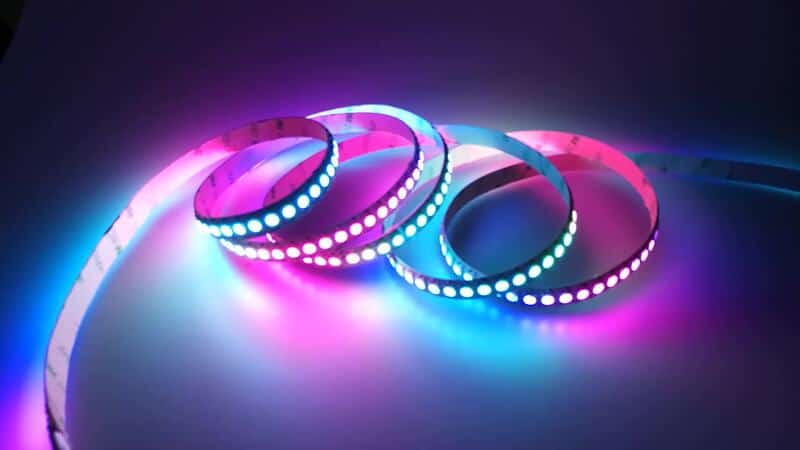
3. Convenience
Controlling your LED strip lighting should be as easy and intuitive as possible. Smartphone apps and universal remote control options go a long way in making your RGB lighting experience more comfortable.
RGBIC and RGBCCT-led strip lights are always good options for buyers looking for an easy and continent lighting setup.
4. Power Adapter
Power adapters for RGB lighting can often cost more than the strip lights themselves. The reason is that most countries use a 120v (in NA) or 240v (in EU) electricity supply that needs to be stepped down to 12v or 24v. RGB lighting power adapters become more effective for longer LED strips.
5. Reliability
Most modern RGB LED strip lights are very efficient and can continuously run for hours. But moisture and sudden electricity surcharge can easily damage the diodes on the strip. High-quality RGB strips have better capacitors and resistors to prevent burnout and come with a watertight outer coating to prevent moisture damage.
Conclusion
RGB and RGBW LED strip lights are just the beginning of the vast and intriguing world of RGB strip lighting.
Several variations of RGB lighting have been introduced to deal with the shortcoming of standard RGB LED strip lights.
Additional white light diodes, independent control chips, and versatility LED controllers have broadened the applications of RGB LED lights. Learn about outdoor RGB LED lighting here.
RC Lighting Is Your One-Stop Shop for Premium RGB LED Strip Lights
RC Lighting is a leading manufacturer of high-quality LED lighting solutions. We are committed to bringing you the best lighting fixtures quickly and within budget.
Our extensive catalog of Indoor & Outdoor lighting solutions can be tailor-made to suit your lighting needs. Get the help of our expert designers and engineers to realize your ideal lighting setup.
You can rest assured knowing that you are getting CE & RoHS-certified products that comply with international safety standards. We also offer a standard 5-year warranty on our products.
Take advantage of our 24/7 customer service and Get a Quick Quote!



